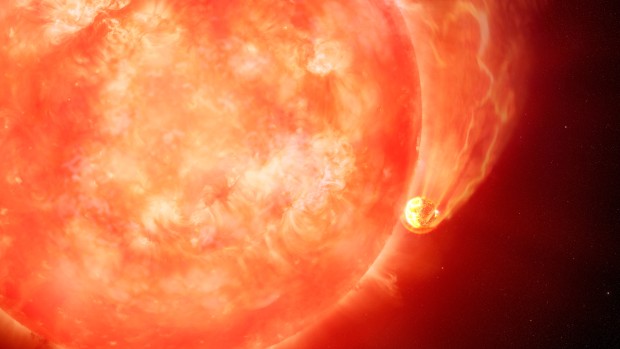The first-of-its-kind observation is a stark preview of Earth’s fate.

For the first time, astronomers have spotted an aging star in the act of swallowing one of its planets, as shown in this artist’s depiction. Credit: International Gemini Observatory/NOIRLab/NSF/AURA/M. Garlick/M. Zamani
In a few billion years, our aging Sun will run out of hydrogen fuel in its core and begin to swell, eventually engulfing Mercury, Venus, and probably Earth itself. Known as the red giant phase, this is a normal step in a mid-sized star’s life cycle, when it swells to hundreds of times its usual size. There are plenty of red giants in the night sky, but astronomers have never caught one in the act of swallowing its planets — until now.
Kishalay De, of MIT, first noticed the star while hunting for novae. A nova is when a star suddenly brightens, usually because it’s siphoning material from another star orbiting nearby; this material can build up and eventually cause a runaway nuclear reaction on the surface of the star. At first glance, that’s exactly what was happening with an event called ZTF SLRN-2020, a star that brightened and then dimmed over about a week of observations.
But when De looked closer with the Keck Observatory on Maunakea in Hawaii, he realized it didn’t look like a regular nova. Novae are hot, and this event was relatively cool. Another red flag was that Keck’s spectral data told him that the material being consumed was molecular. Anything stolen directly from another star would be so hot it would be ᵴtriƥped of any molecular bonds, leaving only isolated atoms of hydrogen or helium.
De looked with more telescopes and more surveys, stretching further back in time. He found that the star had brightened in the infrared a year before the visible light flared. This was not like a regular nova, and gave his team the clues needed to unravel the mystery — instead of material from a nearby star, this star had swallowed a Jupiter-sized planet. They published their discovery May 3 in Nature.
Ch-ch-ch-changes
The find was made possible by the Zwicky Transient Facility (ZTF), a program running at Caltech’s Palomar Observatory in California that repeatedly scans the sky to watch for things that change from one image to the next. Surveys like ZTF flag objects that appear, disappear, or change in brightness, and serve as a record of how the sky looked in the past, even if scientists weren’t actively monitoring a particular star.
Astronomers have previously spotted so-called “polluted” white dwarfs — stars that contain heavy materials that otherwise shouldn’t exist in a white dwarf. This is evidence that they already consumed planets rich in metals (the term astronomers use for any element heavier than helium). But seeing the light and heat from the feeding process is a new privilege for astronomers.
As the star expanded, the planet began experiencing drag as it plowed through the star’s outer layers and began to spiral in. Eventually, the star consumed the planet entirely, causing the flash of light that caught scientists’ notice. Credit: R. Hurt/K. Miller (Caltech/IPAC)
As the planet fell into its star, the star began to rip away the planet’s outer layers. At the same time, the planet — a Jupiter-sized giant — began to tug on the star’s puffy outer layers. This material drifted away from the star and cooled, causing the infrared glow that astronomers spotted in their follow-up work. This glow went on for a year as the planet spiraled closer to its star.
The visible flash, the first sign that astronomers noticed, was actually one of the last steps, as the star swallowed the bulk of its planet and flared hot and bright. As its meal settled, the star returned to its former brightness. From the time it began brightening and returned to normal, about 100 days passed — the blink of an eye in astronomical terms.
The star is very similar to our own Sun. While Jupiter probably orbits far enough to be safe when our Sun becomes a red giant, a similar fate awaits the rocky planets. Perhaps, in five billion years, alien astronomers will see a smaller, Earth-sized blip as our planet plunges into the Sun’s dying embrace.





